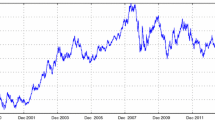Abstract
We use the Kalman filter to estimate the structure of the secret currency basket of the renminbi based on daily data between 2005 and 2009. The currency weights of selected currencies are modeled as stochastic processes (random walks). The official announcement of the new exchange rate regime in July 2005 with the introduction of a secret currency basket was followed by a smooth appreciation against the US dollar (USD). Other currencies did not play a major role. We show that the USD again received a higher weight in the Chinese exchange rate policy already before the financial crisis of 2008.



Similar content being viewed by others
Notes
Only later, for example in June 2010, the PBC stressed the importance of exchange rate stability for the development of the Chinese economy in the aftermath of the financial crisis.
Frankel and Xie (2010) discuss the estimation of structural changes of exchange rate policies for several countries, but excluding China.
Figure 2 presents the results in a table in which each column shows one specification with one or several currencies that are possibly included in the currency basket of the renminbi. The presentation thus largely corresponds to a standard table with regression results. However, each time-varying coefficient is shown as a figure including standard confidence bands.
The results for other currencies are available upon request from the author.
The coefficients for the EUR and the JPY become insignificant if the estimation period is extended to 2009.
References
Bussière, M, Fidrmuc, J and Schnatz, B . 2008: EU enlargement and trade integration: Lessons from a gravity model. Review of Development Economics 12: 501–515.
Calvo, GA and Reinhart, CM . 2002: Fear of floating. Quarterly Journal of Economics 117 (2): 379–408.
Eichengreen, B and Tong, H . 2005: Is China's FDI coming at the expense of other countries. Working Paper No. 11335, National Bureau of Economic Research, Cambridge, http://www.nber.org/papers/w11335.
Frankel, JA . 2006: On the yuan: The choice between adjustment under a fixed exchange rate and adjustment under a flexible rate. CESifo Economic Studies 52 (2): 246–275.
Frankel, JA . 2009: New estimation of China's exchange rate regime. Pacific Economic Review 14 (3): 346–360.
Frankel, JA and Wei, S-J . 2007: Assessing China's exchange rate regime. Working Papers 13100, National Bureau of Economic Research.
Frankel, JA and Wei, S-J . 2008: Estimation of de facto exchange rate regimes: Synthesis of the techniques for inferring flexibility and basket weights. IMF Staff Papers 55 (3): 384–416.
Frankel, JA and Xie, D . 2010: Estimation of de facto flexibility parameter and basket weights in evolving exchange rate regimes. American Economic Review 100 (2): 568–572.
Funke, M and Gronwald, M . 2008: The undisclosed renminbi basket: Are the markets telling us something about where the renminbi-US dollar exchange rate is going? World Economy 31 (12): 1581–1598.
Harvey, AC . 1989: Forecasting, structural time series models and the Kalman filter. Cambridge University Press: Cambridge.
Korhonen, I and Ritola, M . 2009: Renminbi misaligned – Results from meta-regressions. Discussion Papers No. 13/2009, Bank of Finland, Institute for Economies in Transition (BOFIT), Helsinki.
McKinnon, R . 2006: China's exchange rate trap: Japan redux? American Economic Review 96 (2): 427–431.
McKinnon, R, Lee, B and Wang, YD . 2009: The global credit crisis and China's exchange rate. Working Paper No. 391, SCID.
McKinnon, R and Schnabl, G . 2008: China's exchange rate impasse and the weak U.S. dollar. Working Paper No. 2386, CESifo Munich.
Meese, RA and Rogoff, KS . 1983: Empirical exchange rate models of the seventies. Journal of International Economics 14: 3–24.
OECD. 2010: OECD economic survey China. OECD: Paris.
Ogawa, E and Sakane, M . 2006: Chinese yuan after Chinese exchange rate system reform. China & World Economy 14 (6): 39–57.
PBC. 2010: Further reform the RMB exchange rate regime and enhance the RMB exchange rate flexibility. News of People's Bank of China, 19 June 2010, Beijing, http://www.pbc.gov.cn/english//detail.asp?col=6400&ID=1488.
Reinhart, CM and Rogoff, KS . 2002: The modern history of exchange rate arrangements: A reinterpretation. Working Paper No. 8963, NBER, Cambridge.
Reinhart, CM and Rogoff, KS . 2004: The modern history of exchange rate arrangements: A reinterpretation. Quarterly Journal of Economics CXIX (1): 1–48.
Reynard, S . 2008: What drives the Swiss Franc? Working Paper No. 2008-14, Swiss National Bank.
Acknowledgements
This research was largely completed during the author's stay at the University of Munich, whose hospitality is appreciated and acknowledged. The author thanks Iikka Korhonen, Sylvia Kaufmann, Doris Ritzberger-Grünwald, Philipp Mayer, Jin Cao, Hubert Gabrisch, Ken Iwatsubo, Yin-Wong Cheung, Elisabeth Beckmann, Xiaobo Zhang, Aaron Mehrotra, Jeffrey Frankel and other participants of the ASSA Atlanta Meeting in January 2010 for helpful comments and suggestions. I acknowledge language advice by Irene Popenberger. The opinions are those of the author and do not necessarily reflect the viewpoint of the Oesterreichische Nationalbank or the Eurosystem. I acknowledge the CESIUK support from the Operational Program of Research and Development in the framework of the European Regional Development Fund (ERDF).
Author information
Authors and Affiliations
Rights and permissions
About this article
Cite this article
Fidrmuc, J. Time-Varying Exchange Rate Basket in China from 2005 to 2009. Comp Econ Stud 52, 515–529 (2010). https://doi.org/10.1057/ces.2010.20
Published:
Issue Date:
DOI: https://doi.org/10.1057/ces.2010.20




